seats NISSAN FRONTIER 2021 Owners Manual
[x] Cancel search | Manufacturer: NISSAN, Model Year: 2021, Model line: FRONTIER, Model: NISSAN FRONTIER 2021Pages: 492, PDF Size: 2.86 MB
Page 9 of 492
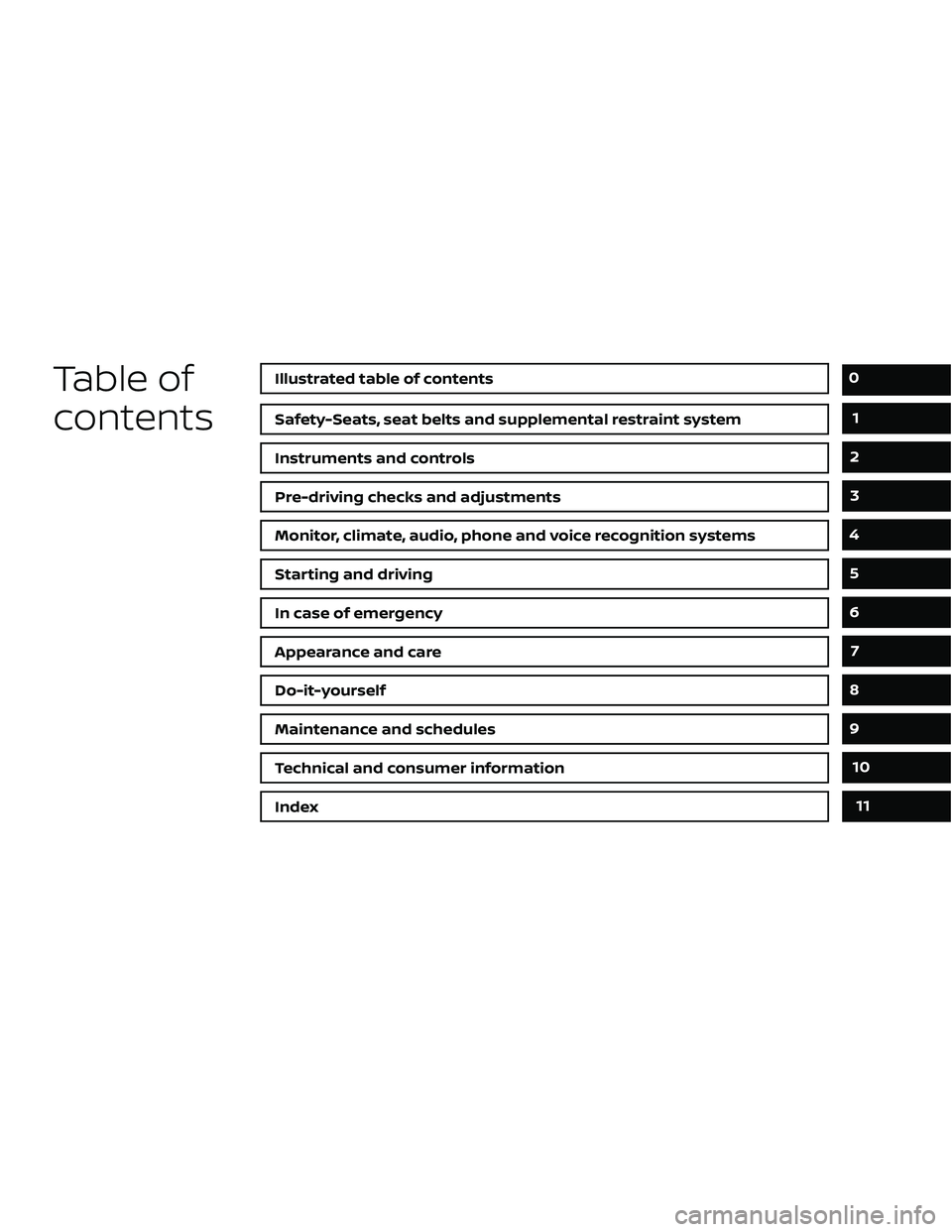
Table of
contents
Safety-Seats, seat belts and supplemental restraint system
Instruments and controls
Pre-driving checks and adjustments
Monitor, climate, audio, phone and voice recognition systems
Starting and driving
In case of emergency
Appearance and care
Do-it-yourself
Maintenance and schedules
Technical and consumer information
Index
0
1
2
3
4
5
6
7
8
9
10
11
Page 12 of 492
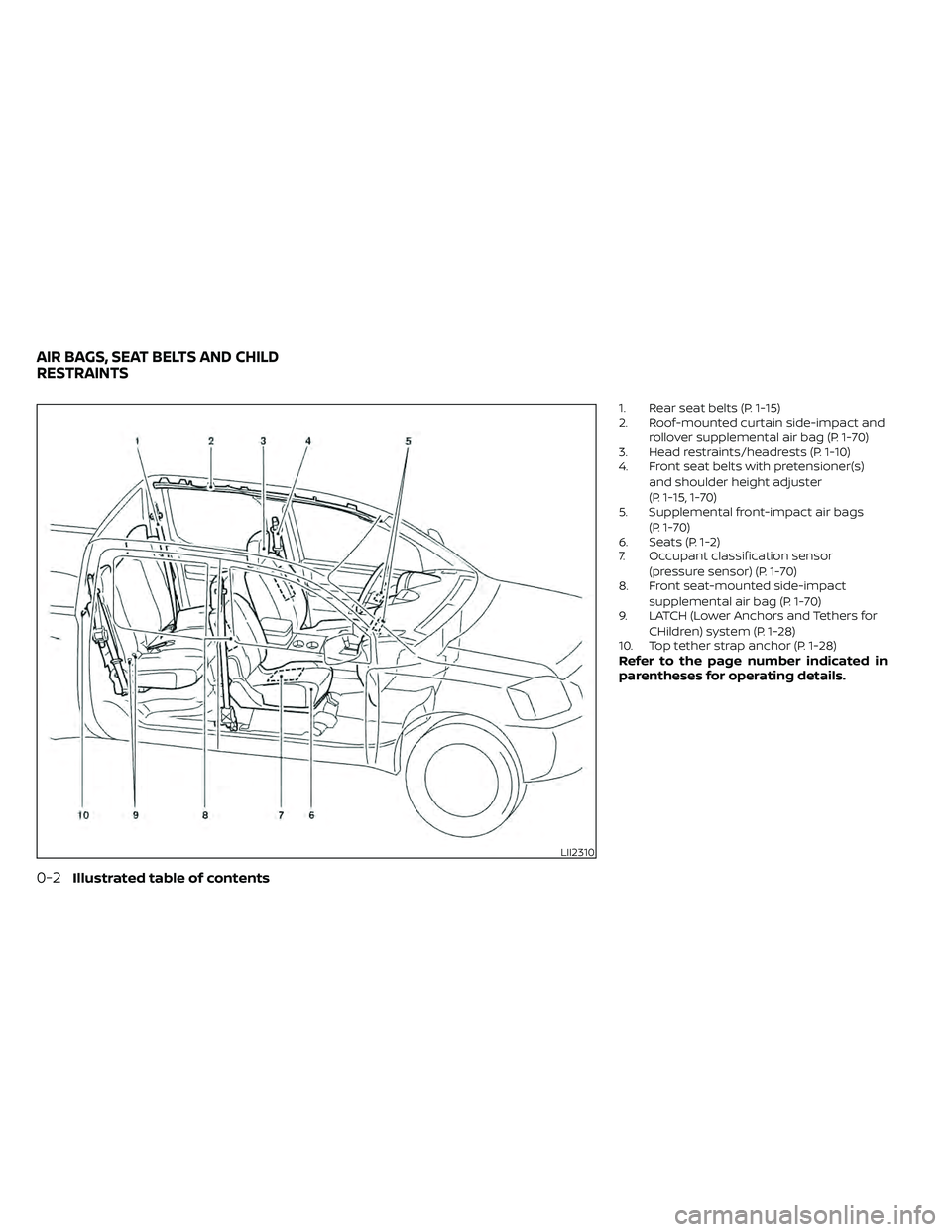
1. Rear seat belts (P. 1-15)
2. Roof-mounted curtain side-impact androllover supplemental air bag (P. 1-70)
3. Head restraints/headrests (P. 1-10)
4. Front seat belts with pretensioner(s)
and shoulder height adjuster
(P. 1-15, 1-70)
5. Supplemental front-impact air bags
(P. 1-70)
6. Seats (P. 1-2)
7. Occupant classification sensor
(pressure sensor) (P. 1-70)
8. Front seat-mounted side-impact
supplemental air bag (P. 1-70)
9. LATCH (Lower Anchors and Tethers for
CHildren) system (P. 1-28)
10. Top tether strap anchor (P. 1-28)
Refer to the page number indicated in
parentheses for operating details.
Page 22 of 492
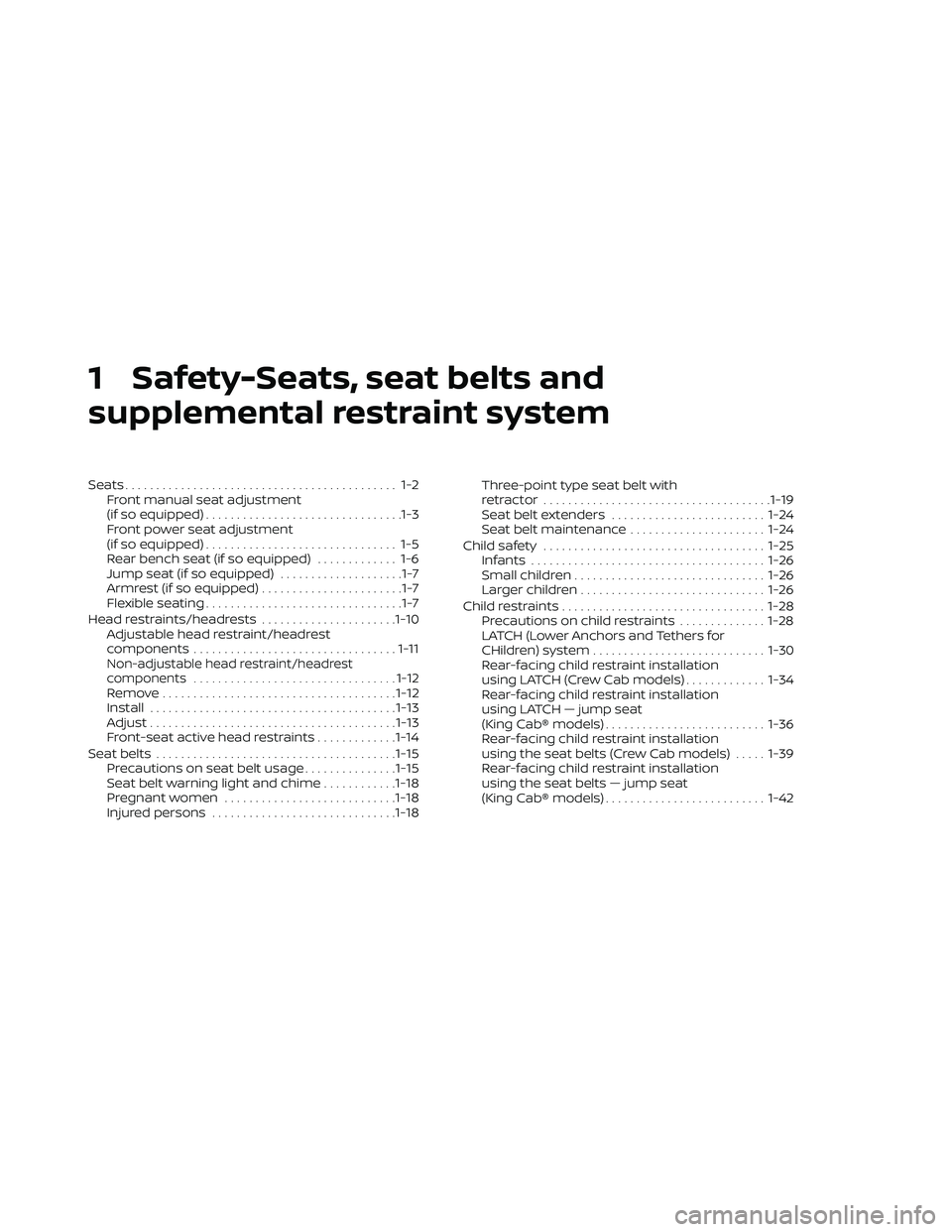
1 Safety-Seats, seat belts and
supplemental restraint system
Seats............................................ 1-2Front manual seat adjustment
(if so equipped) ................................1-3
Front power seat adjustment
(if so equipped) ............................... 1-5
Rear bench seat (if so equipped) ............. 1-6
Jump seat (if so equipped) ....................1-7
Armrest (if so equipped) .......................1-7
Flexible seating ................................1-7
Head restraints/headrests ......................1-10
Adjustable head restraint/headrest
components ................................. 1-11
Non-adjustable head restraint/headrest
components................................. 1-12
Remove...................................... 1-12
Install ........................................ 1-13
Adjust ........................................ 1-13
Front-seat active head restraints .............1-14
Seatbelts ....................................... 1-15
Precautions on seat belt usage ...............1-15
Seat belt warning light and chime ............1-18
Pregnant women ............................ 1-18
Injured persons .............................. 1-18Three-point type seat belt with
retractor .....................................
1-19
Seat belt extenders ......................... 1-24
Seat belt maintenance ......................1-24
Child safety .................................... 1-25
Infants ...................................... 1-26
Small children ............................... 1-26
Larger children .............................. 1-26
Child restraints ................................. 1-28
Precautions on child restraints ..............1-28
LATCH (Lower Anchors and Tethers for
CHildren) system ............................ 1-30
Rear-facing child restraint installation
using LATCH (Crew Cab models) .............1-34
Rear-facing child restraint installation
using LATCH — jump seat
(King Cab® models) .......................... 1-36
Rear-facing child restraint installation
using the seat belts (Crew Cab models) .....1-39
Rear-facing child restraint installation
using the seat belts — jump seat
(King Cab® models) .......................... 1-42
Page 25 of 492
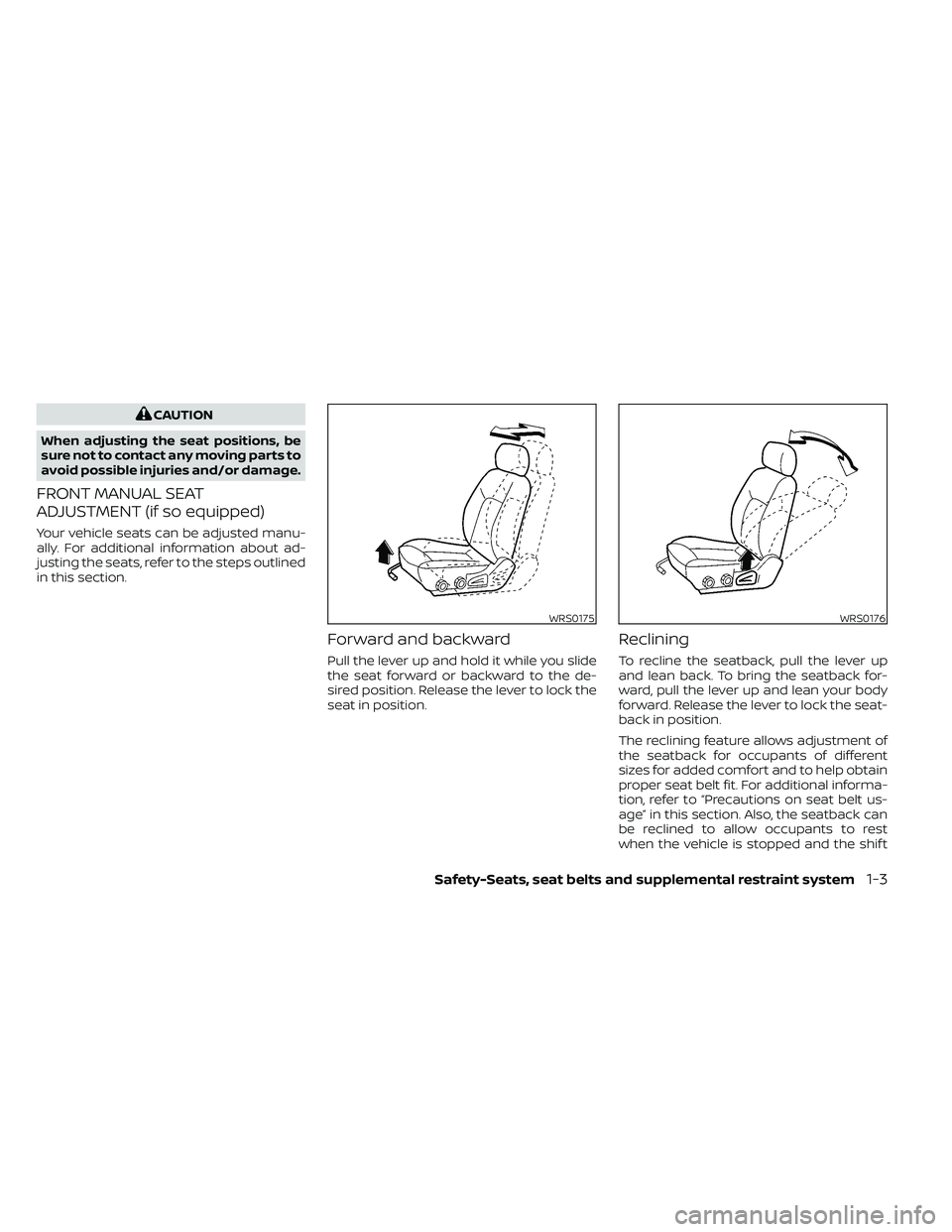
CAUTION
When adjusting the seat positions, be
sure not to contact any moving parts to
avoid possible injuries and/or damage.
FRONT MANUAL SEAT
ADJUSTMENT (if so equipped)
Your vehicle seats can be adjusted manu-
ally. For additional information about ad-
justing the seats, refer to the steps outlined
in this section.
Forward and backward
Pull the lever up and hold it while you slide
the seat forward or backward to the de-
sired position. Release the lever to lock the
seat in position.
Reclining
To recline the seatback, pull the lever up
and lean back. To bring the seatback for-
ward, pull the lever up and lean your body
forward. Release the lever to lock the seat-
back in position.
The reclining feature allows adjustment of
the seatback for occupants of different
sizes for added comfort and to help obtain
proper seat belt fit. For additional informa-
tion, refer to “Precautions on seat belt us-
age” in this section. Also, the seatback can
be reclined to allow occupants to rest
when the vehicle is stopped and the shif t
WRS0175WRS0176
Page 26 of 492
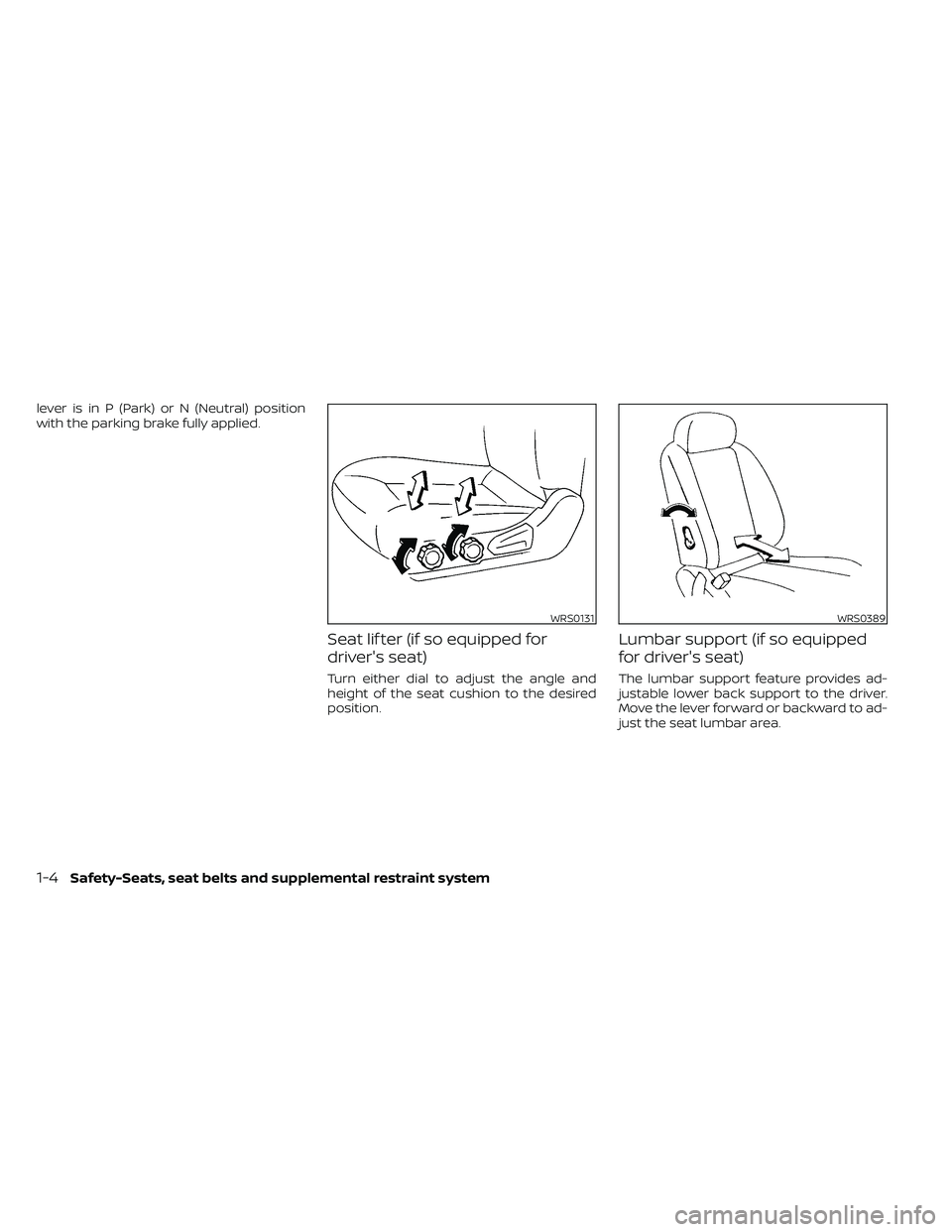
lever is in P (Park) or N (Neutral) position
with the parking brake fully applied.
Seat lif ter (if so equipped for
driver's seat)
Turn either dial to adjust the angle and
height of the seat cushion to the desired
position.
Lumbar support (if so equipped
for driver's seat)
The lumbar support feature provides ad-
justable lower back support to the driver.
Move the lever forward or backward to ad-
just the seat lumbar area.
WRS0131WRS0389
1-4Safety-Seats, seat belts and supplemental restraint system
Page 28 of 492
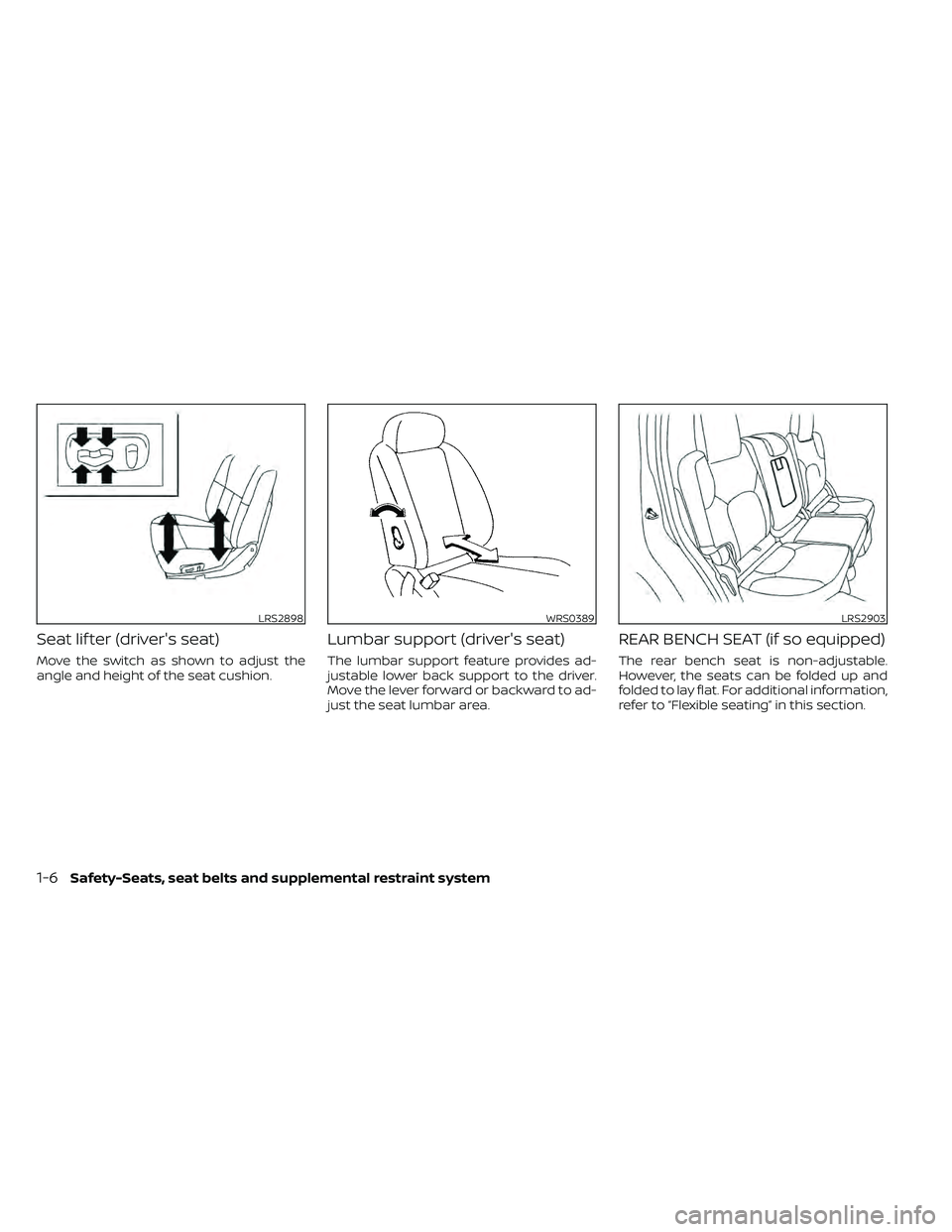
Seat lif ter (driver's seat)
Move the switch as shown to adjust the
angle and height of the seat cushion.
Lumbar support (driver's seat)
The lumbar support feature provides ad-
justable lower back support to the driver.
Move the lever forward or backward to ad-
just the seat lumbar area.
REAR BENCH SEAT (if so equipped)
The rear bench seat is non-adjustable.
However, the seats can be folded up and
folded to lay flat. For additional information,
refer to “Flexible seating” in this section.
LRS2898WRS0389LRS2903
1-6Safety-Seats, seat belts and supplemental restraint system
Page 30 of 492
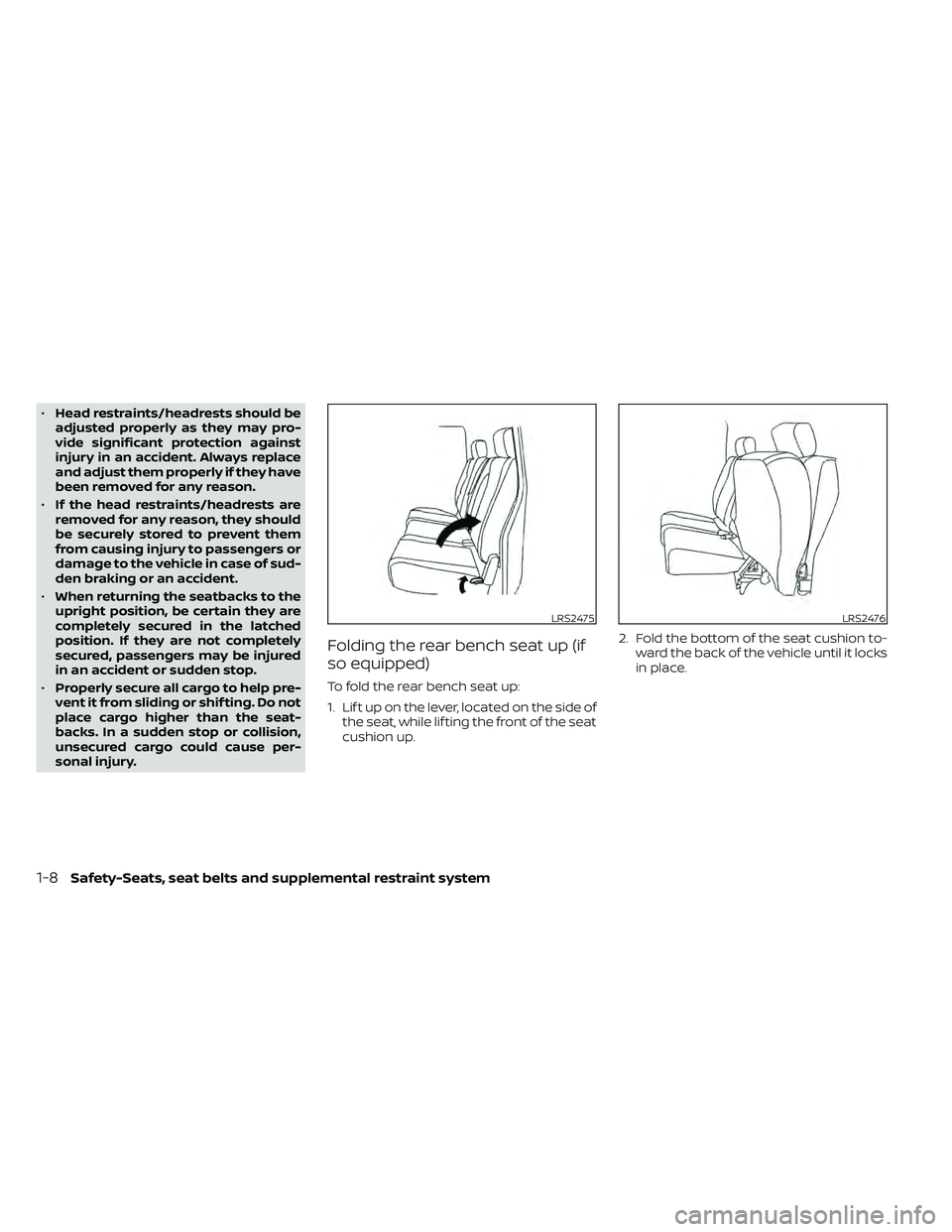
•Head restraints/headrests should be
adjusted properly as they may pro-
vide significant protection against
injury in an accident. Always replace
and adjust them properly if they have
been removed for any reason.
• If the head restraints/headrests are
removed for any reason, they should
be securely stored to prevent them
from causing injury to passengers or
damage to the vehicle in case of sud-
den braking or an accident.
• When returning the seatbacks to the
upright position, be certain they are
completely secured in the latched
position. If they are not completely
secured, passengers may be injured
in an accident or sudden stop.
• Properly secure all cargo to help pre-
vent it from sliding or shif ting. Do not
place cargo higher than the seat-
backs. In a sudden stop or collision,
unsecured cargo could cause per-
sonal injury.
Folding the rear bench seat up (if
so equipped)
To fold the rear bench seat up:
1. Lif t up on the lever, located on the side of the seat, while lif ting the front of the seat
cushion up. 2. Fold the bottom of the seat cushion to-
ward the back of the vehicle until it locks
in place.
LRS2475LRS2476
1-8Safety-Seats, seat belts and supplemental restraint system
Page 31 of 492
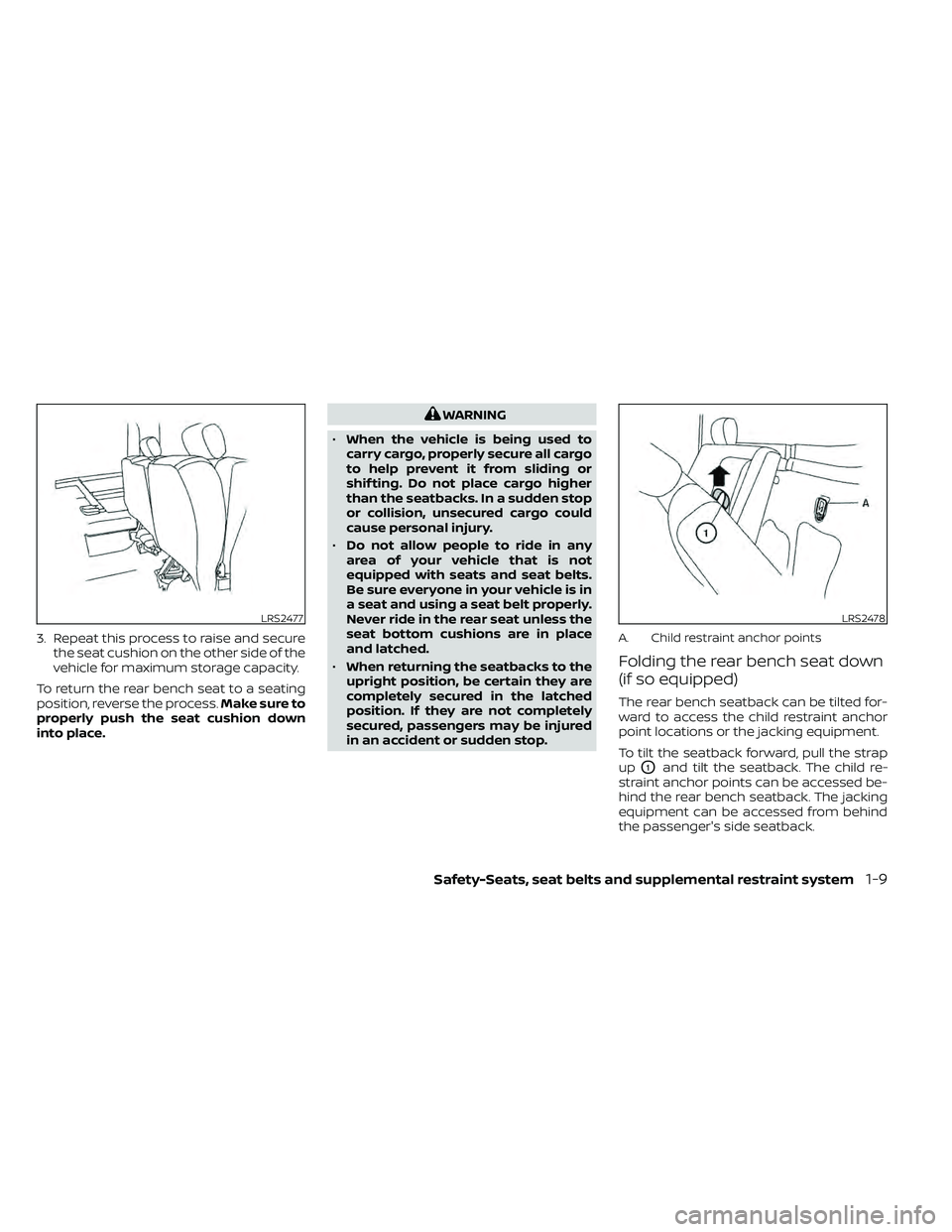
3. Repeat this process to raise and securethe seat cushion on the other side of the
vehicle for maximum storage capacity.
To return the rear bench seat to a seating
position, reverse the process. Make sure to
properly push the seat cushion down
into place.
WARNING
• When the vehicle is being used to
carry cargo, properly secure all cargo
to help prevent it from sliding or
shif ting. Do not place cargo higher
than the seatbacks. In a sudden stop
or collision, unsecured cargo could
cause personal injury.
• Do not allow people to ride in any
area of your vehicle that is not
equipped with seats and seat belts.
Be sure everyone in your vehicle is in
a seat and using a seat belt properly.
Never ride in the rear seat unless the
seat bottom cushions are in place
and latched.
• When returning the seatbacks to the
upright position, be certain they are
completely secured in the latched
position. If they are not completely
secured, passengers may be injured
in an accident or sudden stop.
A. Child restraint anchor points
Folding the rear bench seat down
(if so equipped)
The rear bench seatback can be tilted for-
ward to access the child restraint anchor
point locations or the jacking equipment.
To tilt the seatback forward, pull the strap
up
O1and tilt the seatback. The child re-
straint anchor points can be accessed be-
hind the rear bench seatback. The jacking
equipment can be accessed from behind
the passenger's side seatback.
LRS2477LRS2478
Page 34 of 492
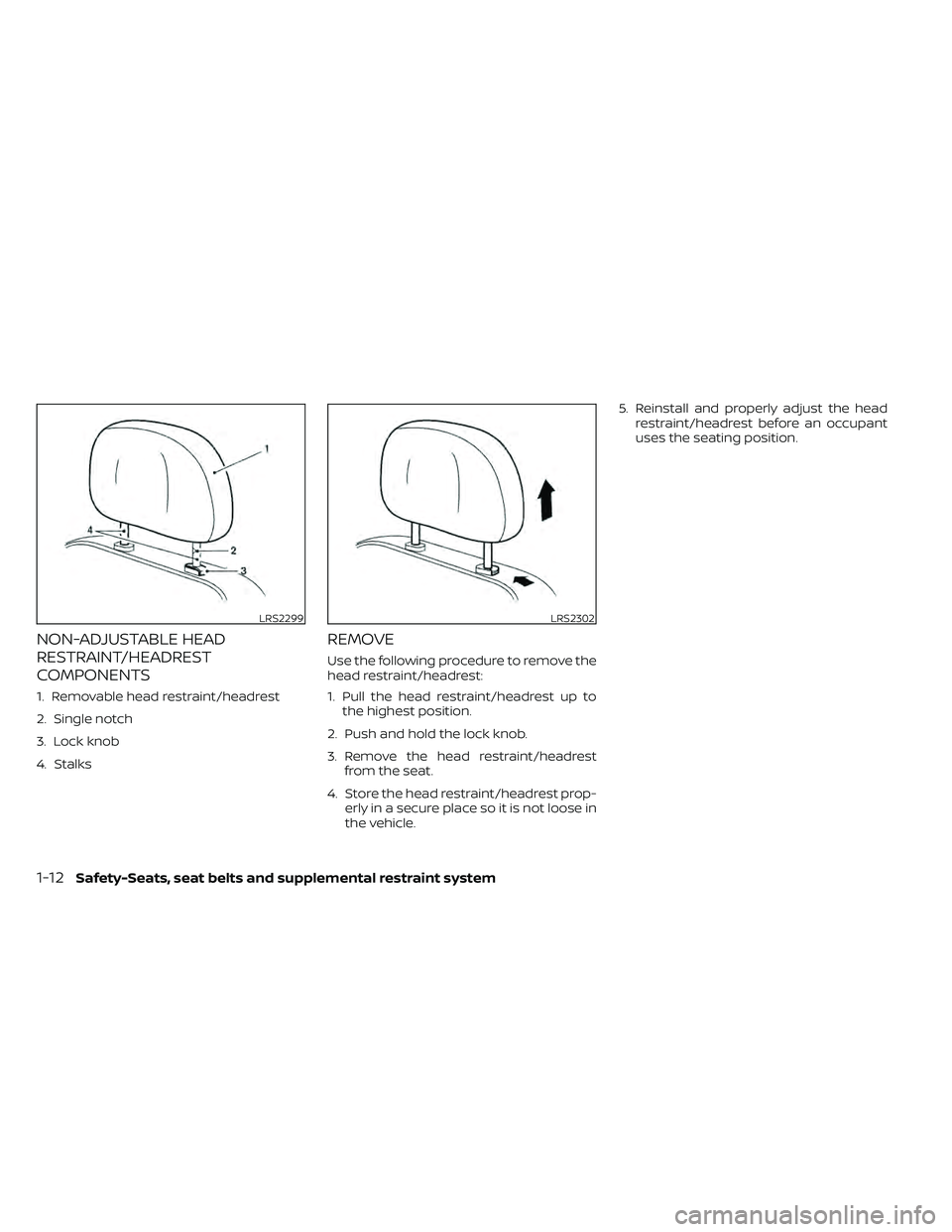
NON-ADJUSTABLE HEAD
RESTRAINT/HEADREST
COMPONENTS
1. Removable head restraint/headrest
2. Single notch
3. Lock knob
4. Stalks
REMOVE
Use the following procedure to remove the
head restraint/headrest:
1. Pull the head restraint/headrest up tothe highest position.
2. Push and hold the lock knob.
3. Remove the head restraint/headrest from the seat.
4. Store the head restraint/headrest prop- erly in a secure place so it is not loose in
the vehicle. 5. Reinstall and properly adjust the head
restraint/headrest before an occupant
uses the seating position.
LRS2299LRS2302
1-12Safety-Seats, seat belts and supplemental restraint system
Page 36 of 492
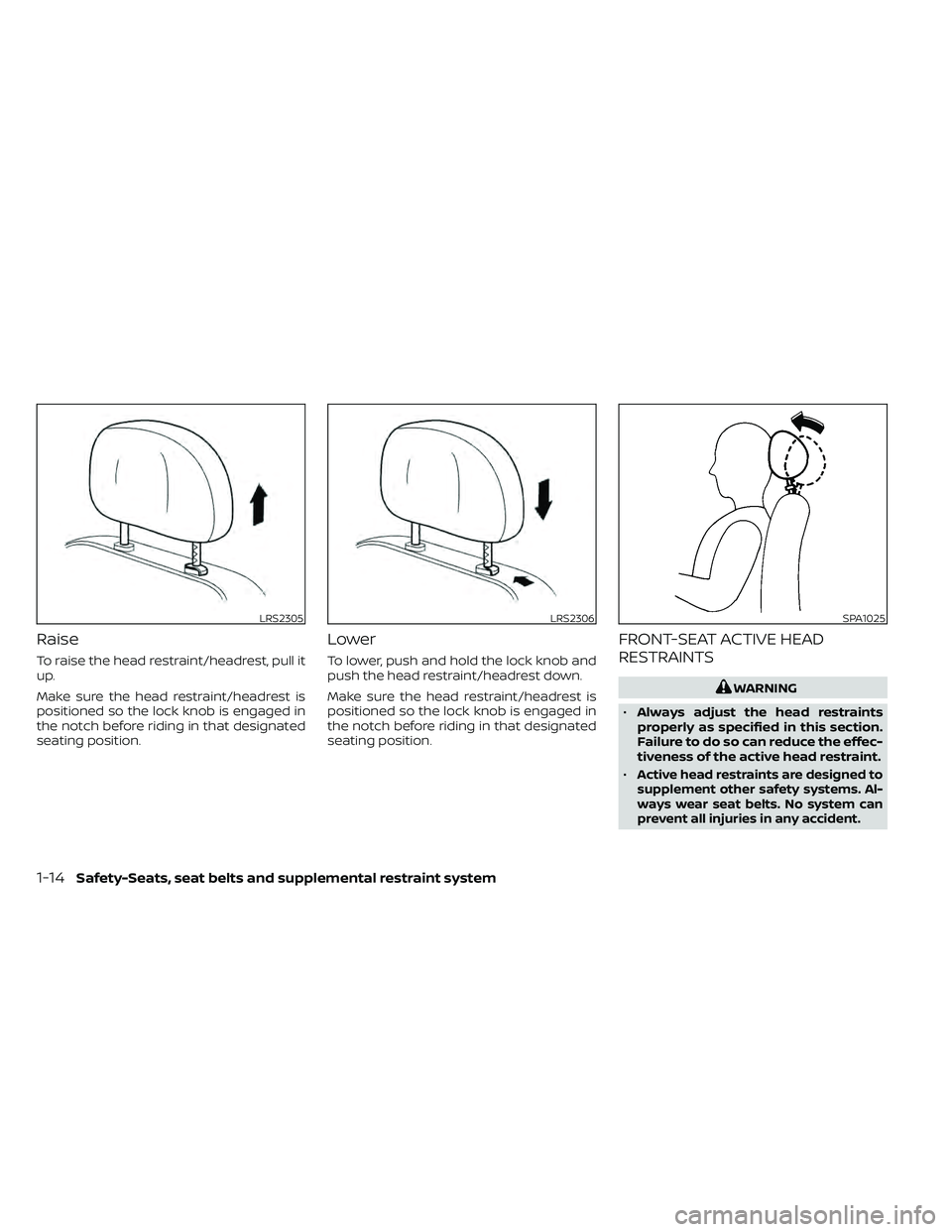
Raise
To raise the head restraint/headrest, pull it
up.
Make sure the head restraint/headrest is
positioned so the lock knob is engaged in
the notch before riding in that designated
seating position.
Lower
To lower, push and hold the lock knob and
push the head restraint/headrest down.
Make sure the head restraint/headrest is
positioned so the lock knob is engaged in
the notch before riding in that designated
seating position.
FRONT-SEAT ACTIVE HEAD
RESTRAINTS
LRS2306SPA1025
1-14Safety-Seats, seat belts and supplemental restraint system